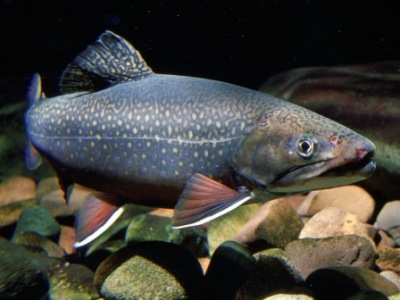The brook trout (Salvelinus fontinalis) is one of the most beautiful freshwater fish native to North America. Brook trout are members of the char family, which includes lake, bull, and blue-backed trout, Dolly Varden, and arctic char.
In freshwater streams, brookies are typically smaller than other trout, typically reaching sizes of 7-12 inches. Occasionally, anglers land fish of 18 inches or more.
Adult brook trout have grayish bodies marked with patterns of red, yellow, orange, and cream spots. Their white tipped fins are an identifying feature.
Brook trout prefer cool streams, especially those that flow through woodlands. They orient to rocks, pools, downed timber, and other stream structure.
In parts of eastern Canada, New York, Vermont, and Maine, brook trout inhabit cool lakes and ponds. Pond and lake-dwelling individuals can grow exceptionally large when food sources are plentiful.
Brook trout are notable regionally for a number of reasons. They are the only stream-dwelling trout native to the Great Lakes. In the Great Lakes region, brook trout known as “coasters” live in lakes and ascend rivers to spawn.
The brook trout is Pennsylvania’s official state fish. Brookies have a cult following in several New England states, where they are also called “square tail”.
In coastal areas, brook trout sometimes adopt anadromous lifestyles, living in saltwater estuaries as adults before returning to freshwater streams to spawn. Known as “salters”, sea-run brook trout are prized for their large size and exceptional table quality.
When brook trout co-occur with other members of the char family, they sometimes spawn together and produce hybrid offspring. Brook trout hybrids are almost always sterile.
Brook trout x brown trout hybrids are known as tiger trout. Brook trout x rainbow trout hybrids are known as cheetah trout.
In western North America, non-native brook trout sometimes spawn with bull trout, resulting in mostly sterile hybrid offspring.
Brook trout are sometimes hybridized with lake trout for regional trout stocking programs. Known as splake, the resulting hybrids can weigh up to 20 pounds or more.
Related Information
